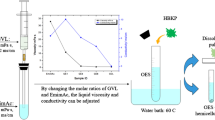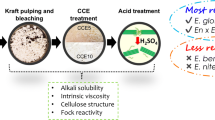Abstract
Magnesium salt is a known cellulose protector during the oxygen delignification process and it has been widely used in commercial practice, in particular, for feedstocks with a low magnesium presence. Minimizing the negative impact of transition metals by magnesium is one of the main mechanisms. A key parameter affecting the magnesium salt performance for this purpose is its particle size. In this study, different particle sizes of magnesium hydroxide were used as additives to the oxygen delignification system, and various transition metal ions (Cu2+, Mn2+ and Fe3+) were added to the radiata pine Kraft pulp. The results show that the magnesium hydroxide particle sizes had negligible effects on the pulp yield, Kappa number and brightness; however, when large size magnesium hydroxide was used, handsheet physical properties suffered a great loss, which was accompanied with much lowered viscosity and degree of polymerization in the resultant pulp. The explanation is that small sized magnesium hydroxide particles have large specific surface area and can adsorb more transition metal ions than the magnesium hydroxide with larger particle size, consequently, the transition metal contents of resultant pulp in the former are significantly lowered, which then decreases the negative impact of transition metals on the cellulose degradation in the process. It is thus concluded that smaller particle size of magnesium hydroxide is favorable as a cellulose protector during the oxygen delignification process.
Graphic abstract




Similar content being viewed by others
References
Bouchard J, Wang J, Berry R (2011) MgSO4 vs. Mg(OH)2 as a cellulose protector in oxygen delignification. Holzforschung 65(3):295–301. https://doi.org/10.1515/hf.2011.062
Cao S, Ma X, Lin L, Huang F, Huang L, Chen L (2014) Morphological and chemical characterization of green bamboo (Dendrocalamopsis oldhami (Munro) Keng f) for dissolving pulp production. Bioresources 9(3):4528–4539. https://doi.org/10.15376/biores.9.3.4528-4539
Cateto C, Hu G, Ragauskas A (2011) Enzymatic hydrolysis of organosolv Kanlow switchgrass and its impact on cellulose crystallinity and degree of polymerization. Energy Environ Sci 4(4):1516–1521. https://doi.org/10.1039/c0ee00827c
Defaye J, Gadelle A (1974) Magnesium salts in the alkaline-oxygen degradation of cellulose. Pulp Pap Can 75:50–53
Eiras KMM, Colodette JL, Silva VL et al (2008) New insights on brightness stability of eucalyptus kraft pulp. Nord Pulp Pap Res J 23(1):102–107. https://doi.org/10.3183/npprj-2008-23-01-p102-107
Ericsson B, Lindgren BO, Theander O (1971) Factors influencing the carbohydrate degradation under oxygen-alkali bleaching. Svensk Papperstid 74:757–765
Gibson YA, Wajer M (2003) The use of magnesium hydroxide as an alkali and cellulose protector in chemical pulp bleaching. Pulp Pap Can 104(11):28–32
Gilbert AF, Pavlovova E, Rapson WH (1973) Mechanism of magnesium retardation of cellulose degradation during oxygen bleaching. Tappi Tech Ass Pulp Pap Indus 56(6):95–99
He Z, Qian X, Ni Y (2006) The tensile strength of bleached mechanical pulps from the Mg(OH)2-based and NaOH-based peroxide bleaching processes. J Pulp Pap Sci 32(1):47–52
Hu H, Zhang H (2009) Substitution of sodium hydroxide with magnesium hydroxide as an alkali source in the peroxide bleaching of softwood TMP. Cellul Chem Technol 43(7–8):325–330
Huang H, Cao S, Ma X et al (2015) Effect of transition metal ions on oxygen delignification of radiata kraft pulp. Paper Pap Mak (China) 34(4):1–9
Huang H, Ma X, Cao S et al (2018) Effect of hemicellulose removal by cold alkali extraction on oxygen delignification of eucalyptus kraft pulp. Pap Sci Technol (China) 37(1):15–18
** H, Hu H, Chai X (2013) Effect of Mg(OH)2 introduction method on pulp hydrogen peroxide bleaching process. J Chem Ind Eng (China) 64(8):3039–3044
Lapierre L, Berry R, Bouchard J (2003) The effect of magnesium ions and chelants on peroxide bleaching. Holzforschung 57(6):627–633. https://doi.org/10.1515/HF.2003.094
Lee JR, Bae JY, Jang W, Lee JH, Choi WS, Koo HY (2015) Magnesium hydroxide nanoplate/graphene oxide composites as efficient adsorbents for organic dyes. RSC Adv 5:83668–83673. https://doi.org/10.1039/c5ra11184f
Li J, Gellerstedt G (1997) The contribution to kappa number from hexeneuronic acid groups in pulp xylan. Carbohyd Res 302(3–4):213–218. https://doi.org/10.1016/S0008-6215(97)00125-0
Liu H, Zong R, Lo S, Hu Y, Zhi Y (2018) Fire extinguishing efficiency of magnesium hydroxide powders under different particle size. Proc Eng 211:447–455. https://doi.org/10.1016/j.proeng.2017.12.035
McDonough TJ (1996) Oxygen delignification. In: Dence CW, Reeve DW (eds) Pulp bleaching principles and practice. Tappi Press, Atlanta, pp 213–240
Ni Y, Van Heiningen ARP (1997) TCF bleaching for the Alcell® process including oxygen delignification: process combines high brightness with high strength. Pulp Pap Can 98(11):38–41
Ni Y, Van Heiningen ARP, Kang GJ et al (1998) Improved oxygen delignification for magnesium-based sulfite pulps. Tappi J 81(10):165–169
Robert A, Viallet A (1971) Degradation of polysaccharides by oxygen in the presence of alkali: protective action of magnesium salts and of silicates. ATIP Rev 25(3):237–241
Sjostrom E, Valttila O (1972) Inhibition of carbohydrate degradation during oxygen bleaching. 1. Comparison of various additives. Paperi Puu 54:695–700
Tavast D, Brännvall E (2017) Increased pulp yield by prolonged impregnation in softwood kraft pul**. Nord Pulp Pap Res J 32(1):14–20
Thakore A, Oei J, Ringrose B et al (2005) The use of magnesium hydroxide as a cost effective cellulose protector in the pressurized alkaline peroxide (Eop) bleaching stage. Pulp Pap Can 106(5):46–49
Vainio A, Paulapuro H (2007) Interfiber bonding and fiber segment activation in paper. BioResources 2(3):442–458
Van Heiningen A, Krothapalli D, Genco J, Justason A (2003) A chemical reactor analysis of industrial oxygen delignification. Pulp Pap Can 104(12):96–101
Violette SM (2003) Oxygen delignification kinetics and selectivity improvement, vol 233. Electronic Theses and Dissertations. https://digitalcommons.library.umaine.edu/etd/233
Wiklund L, Öhman LO, Lidén J (2001) Solid solution formation between Mn(II) and Mg(II) hydroxides in alkaline aqueous solution. Nord Pulp Pap Res J 16(3):240–245. https://doi.org/10.3183/NPPRJ-2001-16-03-p240-245
Zhao H, **g L, Zhang X (2018) Fundamental understanding of distracted oxygen delignification efficiency by dissolved lignin during biorefinery process of eucalyptus. Biores Technol 258:1–4. https://doi.org/10.1016/j.biortech.2018.02.122
Acknowledgments
This work was supported by the National Key Research and Development Program of China (No. 2017YFB0307900), the National Natural Science Foundation of China (No. 31270638) and the Foundation (No. KF201601) of Key Laboratory of Pulp and Paper Science and Technology of Ministry of Education/Shandong Province of China.
Author information
Authors and Affiliations
Corresponding authors
Additional information
Publisher's Note
Springer Nature remains neutral with regard to jurisdictional claims in published maps and institutional affiliations.
Rights and permissions
About this article
Cite this article
Ning, D., Hu, Y., Fu, C. et al. Effect of the particle size of magnesium hydroxide on the cellulose polymerization during the oxygen delignification of radiata pine kraft pulp. Cellulose 26, 6571–6581 (2019). https://doi.org/10.1007/s10570-019-02569-9
Received:
Accepted:
Published:
Issue Date:
DOI: https://doi.org/10.1007/s10570-019-02569-9




